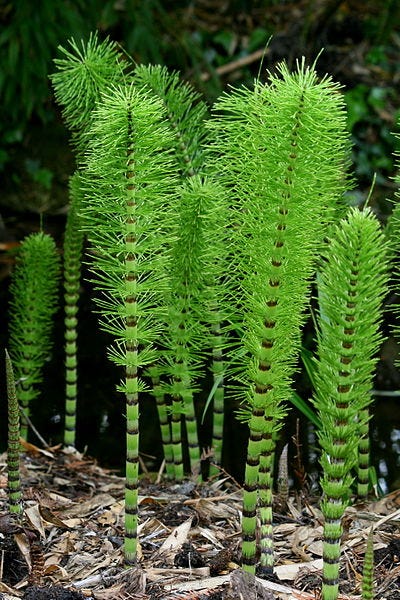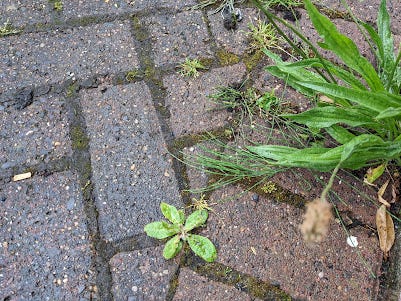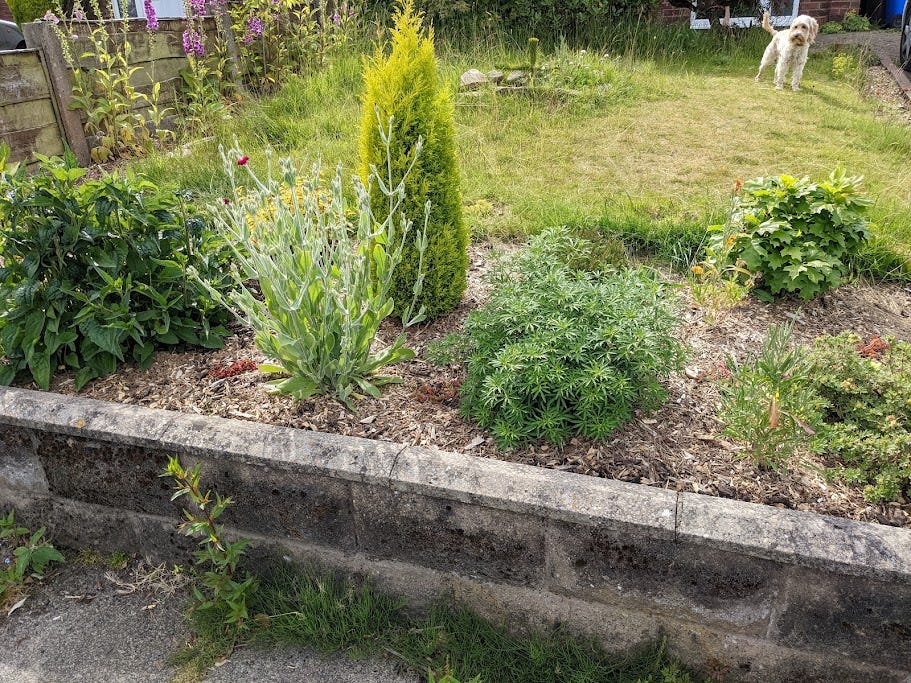Keep trying and trying and...
Or how I redid my front garden multiple times
For your convenience, an index of this deep dive series.
A longer prose piece, this time. I will mix things up and probably alternate with more factual pieces - partly to keep my interest, but also yours, alive.
There’s a wonderful genus of plant named Horsetail, Equisetum. Here are some great snippets from the Wikipedia article to whet your appetite:
[Horsetail] is the only living genus in Equisetaceae, a family of ferns, which reproduce by spores rather than seeds…
Equisetum is a "living fossil", the only living genus of the entire subclass Equisetidae, which for over 100 million years was much more diverse and dominated the understorey of late Paleozoic forests
…Some equisetids were large trees reaching to 30 m (98 ft) tall…
…Field horsetail (E. arvense) can be a nuisance weed, readily regrowing from the rhizome after being pulled out. It is unaffected by many herbicides designed to kill seed plants…
…Members of the genus have been declared noxious weeds in Australia and in the US state of Oregon…
Wait, so there’s this terribly invasive genus of plant called Horsetail, Equisetum, that humans spend lots of money trying to eradicate from their gardens.

So why am I talking about this plant?
A few weeks ago, I was taking my Dog Plant for a walk around the neighbourhood and I spotted a resident spraying something on his soil bed. I stopped to chat and it turned out he was trying to eradicate a certain weed. You guessed it, it was Horsetail. I’d been observing the evolution of his soil bed for a while now. At the beginning, it was just dug over dirt, and then had some kind of cherry laurel that you see so often as hedges in the English landscape. The small cherry laurel plants were in bare soil and what he didn’t know was that Horsetail is endemic in this neighbourhood - there’s practically a specimen in every garden, and as I wrote earlier, they spread by spores so there’s no getting away from them. Horsetail will even grow out of cement and tarmac.

Talking to this man brought back some memories about my own adventures with this Horsetail plant and how I’m actually really thankful to the lessons it has taught me.

Everyone has their own version of this story on my street. Some pummel it out of existence with extreme applications of weedkiller, some rip out their entire garden and replace it with molded concrete (concrete that is designed to look like block paving), or block paving itself, or any permutation and combination of the above.
Pursuit of formality
When I first moved here, four years ago, I noticed that everyone’s front gardens were very well kept. I’m talking manicured lawns, widely spaced plants with dark black soil beds. One day, I saw some neighbour diligently hoeing the surface of their soil beds, and well, we’ve been down this road before. I decided to copy them, and I noticed that there was a lot of this weird wiry plant growing. My lizard hind brain was ticking away though, and I decided that I would copy another neighbour and place a layer of purple slate straight on top of the soil with the idea that it would smother out these odd plants. As you might have predicted, this failed miserably as the horsetail - which I had by now the wherewithal to identify - just grew straight through the slate and became even harder to pull out.
By this time, you might have noticed that I copied people’s gardening habits a lot without thinking deeply and you are right to assume that I blundered on! I saw another neighbour redo their front garden by stripping off all the top soil and adding some plastic landscape fabric, before placing a thick layer of slate down. Of course, my brain went “aha!” and I promptly scooped up the slate (including root fragments of horsetail that would regrow within the slate!), placed the fabric down, and then replaced the slate.
So if you’re keeping count, this is the third time I’ve brutalised the top soil.
Scraping the top soil with a hoe to kill any horsetail (and also all healthy soil microbiome)
Slapping slate straight on top of the top soil, which the horsetail just treated like a holiday to a different country
Scraping up the slate (root fragments of horsetail included for handy regrowth in the slate medium), smothering the already battered soil microbiome in plastic and plonking the slate back on top
Wait, I’ve not finished. My brain was still ticking over and I was reading a bit more widely at this point about mulches. I didn’t want to pay a lot for this so called transformation, and I came across using bark as a mulch. I saw pictures and really liked the look, so off came the slate and on went the decorative bark mulch!
Now this all happened over maybe two years and what I didn’t know was that the soil was pretty much a blighted dessert by this time. How could I, when I couldn’t see it underneath the bark and plastic membrane? The clue was in the plants - of course - as I noticed they were all looking pale, growing really slowly or outright dying. I read even more about weed membranes and found out they split opinion a lot - some thought they were great and others accused them of killing the soil. Adding insult to injury, some horsetail was growing through the membrane! So up came the bark, off came the membrane and back down came the bark.
Here’s how we’re doing now
Scraping up the slate, replacing it with bark
Scraping up the bark, ripping out the membrane for the love of all soil, and replacing the bark
I’m getting tired of just reliving this, but I will march to the end of this story with you.
The fantastic news was now that the plants started to wake up again; some reversed their slow descent to death now that soil life was able to breath again. Of course, the horsetail came roaring back, worse than ever - there was no membrane to trap it in the depths of soil hell.
It was around this point that COVID-19 lock-down happened and we were all trapped in our properties. I had been reading a lot more about mulching with a specific angle on killing this weed that had survived all my attempts to suppress it. I finally came across the idea of placing cardboard between the soil and the mulch, acting as a great breathable weed suppressant whilst slowly decaying. I looked in my shed and saw all the hoarded cardboard boxes and so off I went. Up went the bark, down came the cardboard, down went the bark mulch, and down came another whole tonne of mulch ordered from a local distributor.
Things were looking great, the plants seemed happy, I saw no horsetail anywhere and I declared premature victory.
Until one day. When the horsetail. Came. Back.
Because of course it would, it’s got metres deep roots, it’s survived the extinction of the dinosaurs, multiple ice ages, generations of human persecution. This thing is evolved to survive. When, or if, we wreck this planet, there will just be horsetail and cockroaches.
So, after getting pretty mad, I took some deep breathes and sat down a looked up the properties of horsetail. After all this time, I didn’t know anything about my enemy apart from how stubborn it was to remove. Turns out that the deep tap roots meant it was itself a really great mulch. It collected minerals from deep down, so if I chopped it down where it stood, it fertilised the soil around it. I also found out that it was often an indicator of poor soil, and that it would die down to manageable levels if the soil were healthy and fertile. This I have also found out to be true.
The tale has now gone full circle. From full on persecution of horsetail to anxiously awaiting any of that familiar tufted fern as a great soil amendment. And to me, that is the beauty of agroforestry: using the plants that grow around to their maximum potential, for the benefit of the environment which ends up benefiting us.
And as I eat a wild strawberry that was fed by the dying husk of a horsetail fern, I’m glad I went on this long journey with this prehistoric survivor.
My only regret? That I didn’t use edible plants. The call of the food forest is never far away though…



